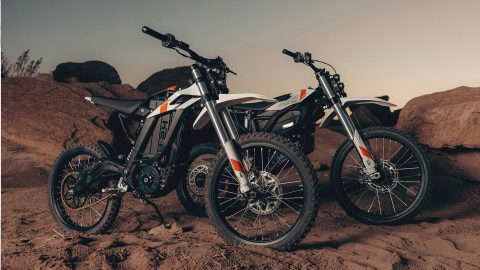Since the early days of the horseless carriage, there have been a number of vehicles built that would be given “icon” status in automotive history. In fact, there are enough iconic cars to fill a parking lot, and each one earned that title in one way or another. Some cars turn to icons through pop-culture like the Ford Mustang; the Jeep earned its rank on the battlefield; the Delorean DMC-12 is forever tied to a cocaine deal; the Aston Martin DB5 became a fashion icon. Some cars earn it by being pinnacles of engineering like the McLaren F1. Then you have cars like the Buick Grand National, a wolf in sheep’s clothing that sucker-punched the automotive world and left us wanting more. Not a muscle car, not a sports car, and attitude too aggressive to be taken seriously as a family sedan.
The Buick Grand National is the only car in the General Motors family tree that could outrun the Corvette’s shadow. But why did Buick build the Grand National? Why was the Buick Regal the platform for a Ferrari-smoking turbocharged V6? And why did General Motors kill the Buick Grand National?
Built to Rebel
The history of the Buick Grand National has been discussed, documented, and published in countless articles, YouTube video essays, and several documentary films. Yet, the Grand National is often overlooked or unintentionally forgotten. In terms of music, the Buick Grand National is the Link Wray of performance cars. If you don’t know who Link Wray is, he is considered to be the father of punk rock who inspired legends like Iggy Pop, Pete Townsend, Neil Young, and Jimmy Page to pick up a guitar. I guarantee you’ve heard Link Wray’s most famous song, “Rumble,” released in 1958.
Link Wray’s “Rumble” was so ahead of its time that certain radio stations in New York banned the song out of fear that the instrumental melody would start gang violence – no joke.
Link Wray’s “Rumble” was so ahead of its time that certain radio stations in New York banned the song out of fear that the instrumental melody would start gang violence – no joke. Yet, like the Grand National, the only people who know of Link Wray are die-hard enthusiasts and people curious enough to do a Google search. Like Link Wray, the Grand National is punk rock. It’s a black sheep, an outsider, built to rebel against the establishment, and like most punk rock songs – it was over too soon.
A New Grandma Car By Buick
At the start of the 1980s, Buick was stepping into its orthopedic slip-on shoes, typecast as the luxury automaker for AARP card members. “Grandma’s Buick” became a saying to represent the slow, cloud-riding sedans parked in the handicap space of every chain grocery store. The brand had drifted a long way in a short time from its last true performance car, the 1970 Buick GSX 455 Stage 1.
The GSX is considered to be one of the most powerful production “muscle cars” of the era, with a massive 7.4-liter V8 turning 510 lb.-ft of torque at less than 3,000 rpm. Less than 680 GSX 455 with Stage 1 packages were built, but more than anything, it proved Buick had the engineering capability to flex as strong as the competition.
It was this way of thinking that drove Lloyd E. Russ, then general manager of Buick, to establish a performance division for the brand. Russ wanted to add some youth to the brand’s demographic, and what better way to attract young car buyers than with speed and flashy graphics.
The name Grand National was borrowed from the NASCAR Winston Cup Grand National Series. In 1981, the Buick had released a redesign of its Regal, a mid-size two-door sedan. The Regal’s stock-car counterpart was a hit on the NASCAR circuit, with driver Darrell Waltrip winning back-to-back championships in 1981 and 1982 in a Buick sponsored Regal stock car. This gave the car plenty of positive publicity under the old car sales motto, “Win on Sunday, sell on Monday.” Russ decided to use this momentum to create an exciting “youthful” performance package.
Buick officially unveiled the Grand National at the 1982 Daytona 500 as a limited edition model. Only 215 Grand Nationals were built during 1982. The success of the launch motivated the company to commit to the idea of building a fast Buick. Car and Driver interviewed many of the original engineers behind the development of the Grand National in 2018. In the article, then-chief assistant engineer for Buick Don Runkle recalled telling his team, “We have to beat the Corvette.”
Turbo Adds Two Cylinders
Building a performance car to show-up, the Corvette meant Buick had little support from General Motors and would need to work with what they had. The Grand National would have been another all-show and no-go appearance package if it were not for its heart and soul, the 3.8-liter turbocharged V6. At the time, the 3.8 V6 had been in production since 1978, producing a respectable 165 horsepower. This engine was developed in 1973 by Buick engineer Ken Baker as a teaching aid for seminars teaching Boy Scouts on the aspects of being a GM engineer – like career day.
In 1975, Russ saw the engine’s potential and appointed Baker to run the program and develop the engine for production. Buick even built an Indy 500 race car in 1976 using the 3.8 turbo V6. When it came time for the 3.8 to meet the Grand National in 1984, the engine was producing 200 hp.
Buick Bets on It All on Black
The original concept designs for the Buick Grand National showed three paint schemes. One was white with a solid blue line across the car’s profile. The second was bright red with a thin black stripe down its side and no chrome trim. The last option was a completely blacked-out Buick Regal with no trim, and it quickly stood out as the favorite.
[T]he 1984 Buick Grand National was featured in an ad campaign strutting to the beat of George Thorogood’s “Bad to the Bone,” setting the tone for what this car was all about – attitude.
In 1984, Russ had been replaced as general manager of Buick with Don Hackworth, who shared Russ’s vision for the car. Under Hackworth’s approval, the 1984 Buick Grand National was featured in an ad campaign strutting to the beat of George Thorogood’s “Bad to the Bone,” setting the tone for what this car was all about – attitude.
Even with the black leather jacket paint job and turbocharger, Buick only produced 2,000 Regal Grand Nationals coupes in 1984 and 2,102 units in 1985 – not exactly a big seller. Critics were quick to assume that the Grand National was merely a flashy appearance package for an otherwise suburban sedan. To see Buick in the early 80s trying to sell a murdered-out Regal with a turbocharger and optional T-top roof must have looked as cringe-worthy as a dad using modern slang around his kids.
However, in 1986, the 3.8 turbo V6 performance figures jumped from 200 to 235 hp with 330 lb.-ft thanks to a new two-piece aluminum intake manifold and the introduction of an intercooler. In April 1986, automotive magazine Car and Driver published its review of the 1986 Buick Grand National with this opening line:
“Corvette, get outta town. Mustang, move over. Camaro, keep your back to the wall at all times. The biggest, baddest gun west of the Pecos is loose in the streets, and there’s gonna be some shootin’….” – Car and Driver, April 1986
Car and Driver clocked the Grand National’s zero to 60 time at 4.9 seconds and its best quarter mile of 13.9 seconds. That meant this big black Buick could accelerate faster than Magnum PI’s red Ferrari 308 GTS and Don Johnson’s white Ferrari Testarossa. Suddenly, the Buick’s reputation went from pretender to contender.
Now, it is important to mention Car and Driver stated in the 2018 article that the Grand National they tested in ’86 was probably making more than the rated 235 hp. It is possible that Buick engineers gave that particular test car a little tune-up to make an estimated 290 hp to improve its performance results. Is that cheating? Well, it’s not honest, but it does not change the fact that it was still a plush interior Buick sedan achieving these performance figures.
Buick GNX, The Black Swan Song
The Buick Grand National production ended at the peak of its popularity in 1987. The prior year Buick decided to stop production of its rear-wheel-drive models and update to new front-wheel-drive platforms. No more rear-wheel-drive meant the Grand National was getting canceled. Fortunately, Buick decided to give it’s Seventh Son a farewell season before shutting it down. In 1986, Buick and tuner company ASC & McLaren began working on the GNX (Grand National Experimental) project.
In conducting research for this article, we managed to find a post on an online Grand National forum called GNTTYPE from 2009 featuring the entire back story of how the GNX project originated. The story is a written statement by Thomas W. Weber, former Chief Technical Officer for ASC & McLaren.
The way Weber tells it, the idea for the GNX happened during the rained-out 1986 Daytona 500. On that day, a group of bored Buick and ASC & McLaren engineers started throwing ideas around, and from that came the concept of unleashing the car’s full potential. Buick would end up collaborating with ASC & McLaren to convert a total of 547 Buick Grand Nationals into GNX models.
In 1987 Buick Grand Nationals were producing 245 hp and 335 lb.-ft, but a GNX package gave you 276 hp with 360 lb-ft. The GNX was designed to be great at doing one party truck – launch the car forward as quickly as possible from a dead stop. The 3.8 V6 was given better flowing heads, a less restrictive exhaust system, lighter turbine wheels for the turbocharger, and improved engine controls.
To effectively use its power for good, ASC stiffened the GNX body and added stiffer rear suspension components featuring a torque-arm that would ensure the transmission and rear axle didn’t flex under the strain of torque during hard launches. The goal was for the car to grip the road and prevent it from wiggling its hips in the process. Other improvements included functional fender louvers to reduce engine heat, a transmission oil cooler, and exclusive GNX badges.
Buick Grand National Breaks GM’s Golden Rule
The golden rule at General Motors is that the Corvette must always be the fastest car in the group. Thomas W. Weber tells the story of the infamous Callaway Corvette versus GNX drag race that took place in 1987. The amateur video shows Weber in an ’87 Buick GNX beating a red 1987 Callaway B2K Twin-Turbo Corvette. The BSK was a special performance package for the C4 Corvette offered by dealers and installed by Reese Callaway’s tuning company. In 1987, Callaway’s twin-turbo kit would boost the C4’s factory rated 240 hp and 345 lb.-ft to a staggering 345 hp and neck-snapping 465 lb.-ft.
The higher-ups at GM made it clear that no drag racing was to be had. Whether that was because GM was secretly nervous about the Corvette losing face to a Buick or simply to avoid unnecessary risk in damaging a vehicle is left to speculation.
Now, according to Weber, the intended plan was to do a photoshoot with the Buick GNX and Callaway C4 Corvette at a drag strip. The higher-ups at GM made it clear that no drag racing was to be had. Whether that was because GM was secretly nervous about the Corvette losing face to a Buick or simply to avoid unnecessary risk in damaging a vehicle is left to speculation. Nevertheless, you cannot gather a group of gearheads at a race track with two state-of-the-art performance cars and expect them not to drag race. After the photos were done, the two cars immediately lined up for a race.
Weber stated that four races were done, with the GNX winning them all. This would go on to be the definitive moment in the Buick Grand National’s short career. The car built to rebel against Buick’s Werther’s Original flavored stigma was caught on tape breaking the golden rule. However, thanks to Weber’s describing the events; we now have a better understanding of why the more powerful Corvette couldn’t hang with the big heavy Buick.
It comes down to traction and weather. Weber describes the day as late in the afternoon with grey clouds and cold air. The Callaway Corvette struggled to find grip and would spill its power all over the track in clouds of tire smoke. The GNX Weber drove had been tuned to give quicker shifts and had a rudimentary launch control system in which all Weber had to do to get the perfect launch was put his left foot on the brake while revving the engine to 1,900 rpm. When it was time to go, he would release the brake and shove his right foot into the throttle and allow the car’s engine management computer to handle the rest. Plus, the GNX was wearing the widest set of street-legal tires to improve handling.
It didn’t matter that the Callaway Corvette would eventually pass the GNX on a long enough straightaway. The Buick Grand National GNX had achieved its goal.
Buick Grand National GNX Leaves Undefeated
They say you should always leave on a high note, and the Buick Grand National did just that when production ended on December 11, 1987. The last Buick Grand National to roll off the assembly line was also the last car ever to be assembled at the GM plant in Pontiac, Michigan, which had been in service since 1927. The Buick Grand National GNX went out being the quickest car in America in 1987. The only cars that could match its performance stats were exotics worth triple the cost of the black turbo sedan. In total, Buick built 20,740 Grand Nationals, and only 547 were GNX conversions.
The Buick Grand National GNX went out being the quickest car in America in 1987.
By 1988, the Buick Regal was a front-wheel-drive model, thus putting a period at the end of the Grand National’s legacy. Even today, some 35 years later, fans of the car still maintain a romantic hope that GM will allow Buick to bring back its black sheep to a new generation of turbocharging technology. The irony of it all is that right now, Buick finds itself in a similar image crisis it faced 40 years ago. It would be fascinating to see if Buick could catch lightning in a bottle again.
If there is anything to be learned from the story of the Buick Grand National, it’s that some rules are meant to be tested for flexibility. The Grand National is a car living in its own era between the energy crisis of 1979 and the start of the dot com boom of 1995. The peak of its collector car value happened in 2015 when someone paid $165,000 for a Buick Grand National GNX with only 352 miles on its odometer. In 2019, automotive auction site Bring a Trailer sold its most expensive Grand National GNX with only 28,000 original miles for $60,000. So if you want a real Buick Grand National, they are not as expensive as they used to be – for now.
The Buick Grand National is a car that promoted innovation in a V6 engine that could perform like a V8 while indulging in former muscle car glory nostalgia. It’s every lone gunman in a western film, a class clown, and an anti-hero all in one. The car was built to go against everything people expected from it while giving it the finger. The next time you see a Buick Grand National from the 1980s at the local car meet or event, take a moment to stare, study, appreciate the punk rock of cars.





















